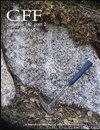Geodynamic setting of Ediacaran and Permian–Triassic plagiogranites of the Ust-Bel’sky and Algansky terranes, West Koryak fold belt, NE Russia: insights from U–Pb geochronology and geochemistry
IF 1.2
4区 地球科学
Q2 GEOLOGY
引用次数: 2
Abstract
ABSTRACT Ediacaran and Permian‒Triassic stages of plagiogranite magmatism are distinguished for the Ust-Bel’sky and Algansky terranes of the West Koryak fold belt, NE Russia. The U‒Pb ages of Ediacaran plagiogranites are 556 ± 3 Ma (SIMS data) and 538 ± 7 Ma (LA–ICP–MS data), respectively, and 235 ± 2 Ma (SIMS data) for the Permian‒Triassic plagiogranites. The Ediacaran and Permian‒Triassic plagiogranites are low-K igneous rocks. Sr‒Nd isotopy and REE patterns of both plagiogranite suites allow suggesting their formation via partial melting of primary mantle material or fractional crystallization of basaltic magma. Ediacaran plagiogranites were formed in the oceanic arc setting contemporaneously with the volcanic-sedimentary complex of Otrozhnaya slice, Ust-Bel’sky terrane. Tuffaceous conglomerates in the lower part of this complex contain Ediacaran zircons with a peak age of 571 Ma. Formation of the Permian‒Triassic plagiogranites took place within the Ust-Bel’sky segment of the Koni‒Taigonos arc via partial melting of melanocratic ophiolite material in the accretionary structure of this arc or fractional crystallization of basaltic magma, melted from such substrate.俄罗斯东北部西Koryak褶皱带Ust-Bel’sky和Algansky地体的埃迪卡拉纪和二叠纪-三叠纪斜长花岗岩的地球动力学背景:从U-Pb地质年代和地球化学的见解
摘要:俄罗斯东北部西科里亚克褶皱带的Ust-Bel’sky和Algansky地体具有埃迪卡拉纪和二叠纪-三叠纪的斜长花岗岩岩浆作用。埃迪卡拉纪斜长岩的U-Pb年龄分别为556±3 Ma(SIMS数据)和538±7 Ma(LA–ICP–MS数据),二叠纪-三叠纪斜长岩为235±2 Ma(SIMS数据)。埃迪卡拉纪和二叠纪-三叠纪斜长花岗岩是低钾火成岩。两个斜长花岗岩套的Sr-Nd同位素和REE模式表明,它们是通过原始地幔物质的部分熔融或玄武岩岩浆的部分结晶形成的。埃迪卡拉纪斜长花岗岩形成于洋弧环境中,与Ust-Bel’sky地体Otrozhnaya切片的火山沉积杂岩同期。该杂岩下部的凝灰质砾岩含有埃迪卡拉纪锆石,峰值年龄为571 Ma。二叠纪-三叠纪斜长花岗岩的形成发生在Koni-Taigonos弧的Ust-Bel’sky段内,通过该弧增生结构中的黑色素蛇绿岩物质的部分熔融或玄武岩浆的部分结晶,从这样的基底熔化。
本文章由计算机程序翻译,如有差异,请以英文原文为准。
求助全文
约1分钟内获得全文
求助全文
来源期刊

Gff
地学-地质学
CiteScore
2.80
自引率
10.00%
发文量
11
审稿时长
>12 weeks
期刊介绍:
GFF is the journal of the Geological Society of Sweden. It is an international scientific journal that publishes papers in English covering the whole field of geology and palaeontology, i.e. petrology, mineralogy, stratigraphy, systematic palaeontology, palaeogeography, historical geology and Quaternary geology. Systematic descriptions of fossils, minerals and rocks are an important part of GFF''s publishing record. Papers on regional or local geology should deal with Balto-Scandian or Northern European geology, or with geologically related areas. Papers on geophysics, geochemistry, biogeochemistry, climatology and hydrology should have a geological context. Descriptions of new methods (analytical, instrumental or numerical), should be relevant to the broad scope of the journal. Review articles are welcome, and may be solicited occasionally. Thematic issues are also possible.
 求助内容:
求助内容: 应助结果提醒方式:
应助结果提醒方式:


